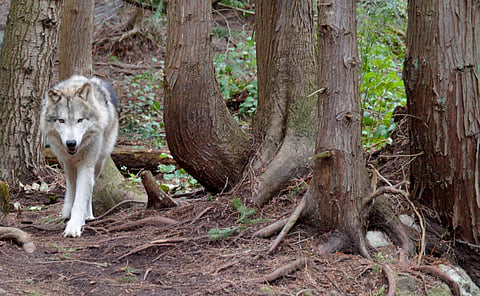Weekend Reads | The Wolves Are Back
by Kevin Schofield
Editors' Note: "Weekend Reads" columnist Kevin Schofield is taking a (much-deserved) week off. So for this weekend's read, we'd like to resurface a previous column about some good news for gray wolves in Washington. Enjoy!
This weekend's read is the annual report from the Washington Department of Fish and Wildlife (WDFW) on its conservation and management program for gray wolves in the state. You probably have heard about gray wolf packs coming back to Eastern Washington, but you may not know the whole fascinating story of gray wolves in the state, with all its ups and downs.
Before about 1850, gray wolves were common throughout the whole state. But with the arrival of American settlers, the wolves started to be heavily hunted, and by the 1930s, there were likely none left in Washington. That remained the case for decades. In 1973, with the passage of the federal Endangered Species Act, protections for gray wolves were put in place: Though they no longer existed in this state, they were still living in our neighbors British Columbia and Idaho. Wolves disperse over time, and with protections in place, it was hoped they would eventually spread back into Washington.
In 2008, the first resident gray wolf pack was confirmed in Eastern Washington. By then, wolf populations in other states had rebounded as well, and through regulatory and court actions, wolves bounced on and off the federal endangered species list several times. With that, the federal and state governments passed back and forth the leading role in wolf recovery here in the state. But despite the buck-passing, since 2008, the wolves have dramatically increased their numbers here — an average increase of 23% per year. As of the end of 2023, there were at least 260 wolves in 42 packs in the state.
Figure 3 courtesy of the Washington Department of Fish and Wildlife.
The WDFW divides the state into three regions for the purposes of tracking wolf repopulation: Eastern; Northern Cascades; and Southern Cascades/Northwest. As of last year's count, 33 packs were in the eastern region and nine were in the Northern Cascades. The prior year, there was one pack in the Southern/Northwest region, but last year it apparently dissolved, leaving none at the moment — though lone individual wolves have been tracked migrating into the region. According to the State's conservation and management plan, if there are at least two successful breeding pairs in each of the three regions, then wolves could be downlisted under state law from "endangered" to "threatened," and with four breeding pairs, they could be downlisted to "sensitive." Since at the moment there are no packs, let alone breeding pairs, in the Southern Cascades/Northwest region, this is not likely to happen soon.
Figure 6 courtesy of the Washington Department of Fish and Wildlife.
When wolves began moving back into the state 16 years ago, ranchers in Eastern Washington raised concerns about the danger to livestock. The WDFW addresses this with an ongoing population monitoring and management plan, costing just over $1.6 million in 2023. The management activities include funding fencing, radio-activated guard boxes, fox lights, and guard dogs, as well as education for ranchers on prevention techniques and range-riding staff to monitor for signs of nearby wolves. The WDFW also compensates ranchers for livestock killed or injured by wolves. The program seems to be working: There were only eight claims for lost livestock last year.
Why should we care about wolf reintroduction? Because they are a critical apex predator in Washington. In the wild, they prey on deer, elk, and other hoofed animals, keeping those populations under control. Without that control, the populations can expand beyond the ability for the ecosystem to support them: They can overfeed on their own food sources (and potentially eliminate them altogether), disperse out of their natural range, and become susceptible to disease. Ecologists call this a "trophic cascade": rapidly removing one layer in the food web affects the populations of both their predators and their prey, and in turn those species' predators and prey. While we're still far from undoing the damage to our state's natural ecosystem that was inflicted when wolves were hunted to extinction here, we seem to be making progress in the right direction — and with some thoughtful work by the WDFW, so far it hasn't created huge disruptions for ranchers. Hopefully the state and federal governments can sort out a more stable plan for who is in charge, and that will ensure continued steady progress for several more decades.
Kevin Schofield is a freelance writer and publishes Seattle Paper Trail. Previously he worked for Microsoft, published Seattle City Council Insight, co-hosted the "Seattle News, Views and Brews" podcast, and raised two daughters as a single dad. He serves on the Board of Directors of Woodland Park Zoo, where he also volunteers.
Featured image via NWE Photography/Shutterstock.com.
Before you move on to the next story …
The South Seattle Emerald™ is brought to you by Rainmakers. Rainmakers give recurring gifts at any amount. With around 1,000 Rainmakers, the Emerald™ is truly community-driven local media. Help us keep BIPOC-led media free and accessible.
If just half of our readers signed up to give $6 a month, we wouldn't have to fundraise for the rest of the year. Small amounts make a difference.
We cannot do this work without you. Become a Rainmaker today!
Help keep BIPOC-led, community-powered journalism free — become a Rainmaker today.


